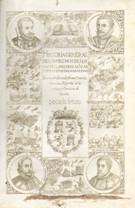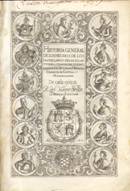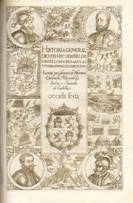larger image 966KBIt was the royal historian Herrera's intent, as the title clearly implies, to glorify the deeds of Spanish conquistadores of Castile, but because he was a conscientious chronicler, he included accounts of deeds that were less than glorious including the sometimes graphic accounts of churchmen of the enslavement and murder of the native Amerindians, and the plundering and devastation of the native cultures at the hands of the Spanish conquerors and governors. Herrera's history, like most history of his day, was a not-always critical compilation, a synthesis of many contradictory sources, woven into a more or less smooth narrative, glorifying the deeds of the Spanish, especially the Castilians, but also acknowledging the cruelty and depredations they inflicted, on one hand sympathetic to the native peoples and their plight, but on the other, like most educated Europeans of his day, considering Indians inferior beings, in need of European culture and religion to evolve into a truly enlightened and civil people. After noting that the Indians lacked iron, gun powder, letters and commerce, he pronounced them to be “barbarous in culture and government.” Elsewhere he poured scorn on their character, describing them as idle, drunken, and low-spirited. Herrera was as honest an historian as someone of his background and position could be. If historical accuracy and truth were not allowed, Herrera stated during the course of an investigation of charges that he had written ill of some of the famous conquistadors, “the reputation of Spain would fall rapidly, for foreign and enemy nations would say that small credence could be placed in the words of her rulers, since their subjects were not allowed to speak freely.” Herrera was not a hypocrite because he believed in the universal history of the Spanish empire and its great mission to civilize and convert to new found worlds to Catholicism
The World of 1601
Blaue Atlas
larger image 967KBJohan Blaeu, 1596-1673. The third centenary edition of Johan Blaeu Le grand atlas: ou, Cosmographie blaviane. Amsterdam , 1663. Amsterdam : Theatrum Orbis Terrarum, 1967 Edition Facsimile.12 Volumes
Willem Janzoon Blaeu (1571-1638) was the founding father of the most important cartographic publishing company in the Netherlands. Born 1571, Blaeu had initially settled in Amsterdam as a musical instrument builder and as a maker of globes. Blaeu soon became the hydrographic expert with the famous East India Company and, in 1633, the chief cartographer of the United Republic of the Netherlands. Amsterdam had by this time emerged as the hub of European cartography. And Blaeu's firm was, for three quarters of a century, certainly the dominant enterprise.
In 1635 he published (together with his son Johan) the first two volumes of his "Le Théatre du Monde ou Nouvel Atlas" which over the years grew to 12 volumes. Blaeu depicted in about 600 maps the entire known world as best as possible regarding cartographic exactness to which he added rich ornamental cartouches and heraldic highlights.
The Spanish Armada had been defeated by the English in 1588. Queen Elizabeth was still on the throne but would die in 1603. The English would not settle their first permanent colony in North America at Jamestown until 1607.
Phillip II of Spain had died in 1598, and had been succeeded by his lazy son Phillip III.
An obscure impecunious soldier and government official named Miguel de Cervantes published the first part of a novel entitled El ingenioso hidalgo don Quijote de la Mancha in 1605. (The second and major part was published in 1615) It was a story of an impoverished delusional hidalgo addicted to the romances of chivalry, who cannot distinguish between the fiction and reality of Spain , blended into one of the great world masterpieces of literature.
larger image 915KBMyth and fable played a considerable role in the Spanish exploration of the New World . The Reconquista of Spain from the Moors had defined Spanish history and Castilian culture. It was a crusade conducted over centuries and embodied in the romantic medieval epic poetry of the idealized 12 th -century life of El Cid. The romance of the Reconquista crossed the Atlantic with the new conquistadors, as they brought Christianity to the unbelievers of the New World at the point of the sword. Like Don Quixote, the conquistadors were led by their own fantasies. Once the Spaniards had uncovered the fantastic riches of the Aztecs and Incas they were only too willing to believe the fairy tales of El Dorado, the Amazons, the White King, the Seven Cities of Gold, the Land of Chicora or Cibola or Quivira, the Mountain of Silver, and the native peoples were quick to grasp the greed induced gullibility of their unwelcome guests and fed the Conquerors the misinformation that lured them inexorably “just a little further on” – poco mas allá – tantalizing the Spanish in their get rich quick schemes, and always moving the Spaniards beyond their own lands, the incurable Quixotic optimism of the Conquistadors.

larger image 723KBColumbus ' first voyage was in 1492 his fourth and last disastrous voyage in 1504. Cortez conquered the Aztec in Mexico and murdered their emperor in 1521; Pizarro conquered the Inca in Peru and murdered their emperor in 1531. The epic and spectacular conquests were completed and the more tortuous and slow work of settlement begun. In 1598 Juan de Oñate, newly appointed adelantado of New Mexico had led an expedition to colonize in New Mexico but in 1601 the colonists deserted the settlement and returned to Mexico. After further colonizing expeditions Santa Fe was established 1609. From the perspective of the United States, Santa Fe was one of the oldest colonial settlements, from the perspective of Spain however it was one of the newest.
Home | Introduction | Decades 1 - 4 | Decade 8 | WDS Home page

